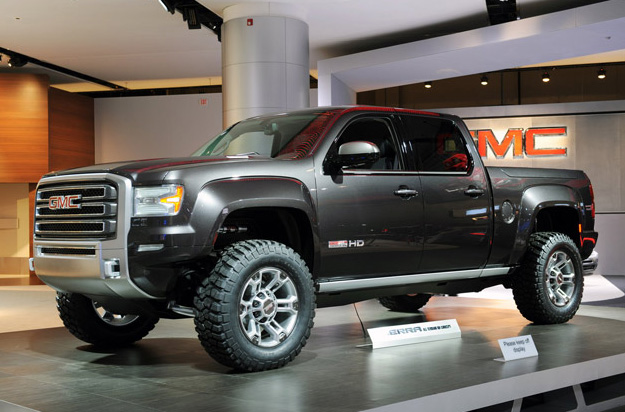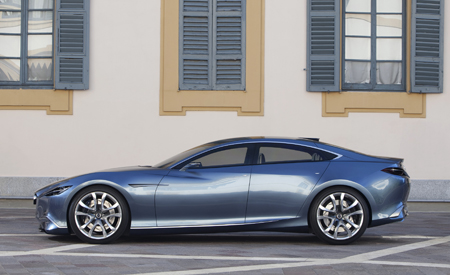2012 Toronto: Four concepts to see + video
In addition to my Top 10 Must-sees from this year’s Toronto show, here are the four true concepts I think you should check out. Video at Toronto Star Wheels, and full text after the jump.
By John LeBlanc
TORONTO – Wrench-off the big wheels, strip-off the exaggerated body kit, remove the Star Wars interior, and underneath most of today’s so-called “concept” cars lies a humdrum production, soon to be available at a dealer near you. But not these four show cars. While some of their technologies and a bit of their styling bits may influence future cars you will eventually get a chance to buy, this quartet of concepts coming to this year’s Toronto auto show will never go on sale as-is:
BMW Vision ConnectedDrive
BMW’s Vision ConnectedDrive two-seat roadster is a true concept car. Unlike previously named “Vision” show cars, BMW has no intention to build this one. The concept, though, does show off the automaker’s latest thoughts in advanced driver assistance aids. First up are sensors in the Vision ConnectedDrive’s head- and tail-lights. They “monitor” traffic around the car, while its exterior rear-view mirrors are antennas, receiving and transmitting navigation data. Next, the driver gets a 3-D heads-up display that can project information about the navigation route. While on the passenger’s side, a dashboard-mounted display allows them to access online information, then send it on to the driver.
First seen: 2011 Geneva auto show Future-tech: Think of the Vision ConnectedDrive as an iPad on wheels. Chances for production: Some of the concept’s looks may end up on a future BMW 1 Series roadster. Or not.
Chevrolet Corvette Stingray
We’ve already seen camouflaged prototypes of the next, seventh-generation Corvette, and the Stingray is not it. Better known for its star role in the movie Transformers: Revenge Of The Fallen as Autobot Sideswipe, Chevrolet’s original intention with the Stingray was to represent “a visionary modern interpretation of the past, present and future of the Corvette.” As such, Chevy says its concept was inspired by two previous Corvettes: the original 1959 Sting Ray race car (which led to the second-generation, early 1960s Corvettes); and the 1965 Mako Shark II (which became the third-generation 1968-1982 models.) In fact, the Stingray was penned in 2003 and its “egg-crate” front grille influenced the look of the current Camaro. The concept’s “Hybrid Stringray” badge is also pure fiction. Under its hood is a conceptual hybrid powertrain, theoretically matching an electric motor with a high performance V8 engine with cylinder deactivation for even better fuel economy in “nonperformance” driving situations.
First seen: 2009 Chicago Auto Show Future-tech: Push-button, scissor-style doors; V8-hybrid powertrain Chances for production: Do you think Corvette fans are ready for a hybrid version? No.
GMC Sierra All Terrain HD
As a retort to rival off-road monsters, like the Ford SVT Raptor and Ram 2500 Power Wagon, comes the GMC Sierra All Terrain HD, a diesel-powered machine that wouldn’t look out of place traversing the Arctic Circle. Based on a 2012 Sierra HD (i.e. heavy duty) short-box crew cab chassis, GMC designers gave the concept truck wider wheel tracks that allegedly enhance the humongous vehicle’s stability during both off-road and highway driving. Aftermarket additions include remote-reservoir Fox Racing off-road shocks, and 20-inch wheels with 35-inch tires. Under the Sierra All Terrain HD’s hood is a production 6.6-litre turbocharged diesel with 397 hp and a tree stump-pulling 765 lb-ft of torque.
First seen: 2011 Detroit Auto Show Future-tech: An electronic front stabilizer bar “disconnect” feature that increases wheel travel and articulation to climb over tall obstacles — such as Chevy Sonics. Chances for production: The current Sierra is at the end of its product cycle. So if GMC does decide to build its Raptor challenger, it will be on the next-generation of trucks, due for 2013.
Mazda Shinari
After spending four years rolling out concepts for its Nagare (Japanese for “flow and the embodiment of motion”) design language, the Shinari was created to introduce the automaker’s new “Kodo” (“soul of motion”) design style. Like the Mercedes-Benz CLS or Audi A7, the Shinari is a “four-door coupe” and many of its design elements — such as its grille that blends into the sleek car’s headlights — are already showing up on new Mazdas, like the 2013 CX-5 compact crossover, and the Takeri, a concept car that appeared at last year’s Tokyo auto show that hints at the next-generation Mazda6 mid-size sedan due next year. While its exterior is already influencing production models, the Shinari’s interior is more futuristic. Mazda says the concept’s next generation Human Machine Interface (HMI) display system offers three distinct modes: “Business” lets enables the driver “stay connected to his work day tasks” via the Internet; “Pleasure” is for comfort and entertainment; “Sport” enables the paddle shifters, tweaks the suspension for “performance driving” and driver controls are simplified to allow the driver to focus on, well, driving.
First seen: 2010 Milan auto show Future-tech: Next-gen HMI Chances for production: The current RX-8 is dead. A replacement may end up being influenced by the Shinari.







![[del.icio.us]](https://www.straight-six.com/wp-content/plugins/bookmarkify/delicious.png)
![[Digg]](https://www.straight-six.com/wp-content/plugins/bookmarkify/digg.png)
![[Facebook]](https://www.straight-six.com/wp-content/plugins/bookmarkify/facebook.png)
![[Google]](https://www.straight-six.com/wp-content/plugins/bookmarkify/google.png)
![[Reddit]](https://www.straight-six.com/wp-content/plugins/bookmarkify/reddit.png)
![[StumbleUpon]](https://www.straight-six.com/wp-content/plugins/bookmarkify/stumbleupon.png)
![[Twitter]](https://www.straight-six.com/wp-content/plugins/bookmarkify/twitter.png)
![[Email]](https://www.straight-six.com/wp-content/plugins/bookmarkify/email.png)